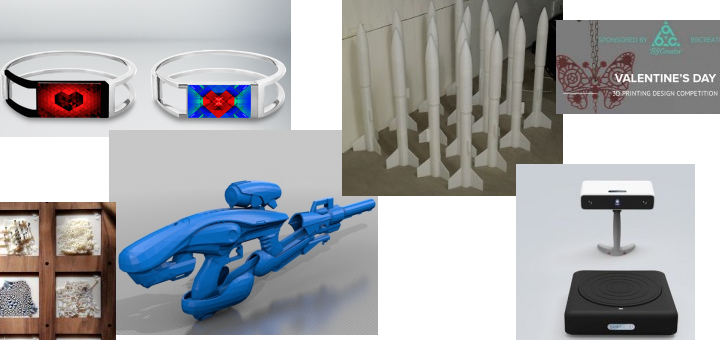Valentine’s Day is right around the corner and it’s best you start thinking about what you will give to that special someone this year. This week’s 3D printing news provides some excellent gift ideas, but if you are planning on skipping this romantic holiday altogether, there are news items noteworthy enough to give you something else to think about. For Valentine’s Day and 3D printing enthusiasts, we have a jewelry design competition that can win you a B9Creator 3D printer, or we have 3D printed customized jewelry that would make an excellent gift. For the Destiny video game enthusiast in your life, we have news of a new Destiny STL Generator application posed on Thingiverse that will allow you to 3D print a number of weapons from the game. If Valentine’s Day celebrations are not in the cards for you, then you’ll have time (and money) to check out a recent 3D printed rocket design competition, a 3D printed topographical display project, and figure out how you can raise money for the new EinScan-S Dektop scanner, which has launched its Kickstarter campaign.
iMakr and B9Creations Partner in Valentine’s Day Jewelry Design Contest
Valentine’s Day is coming up and iMakr’s MyMiniFactory is partnering with B9Creations in a competition to see your 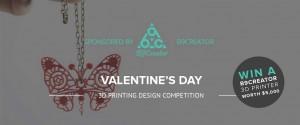 most inventive 3D printable jewelry designs for the occasion. The MyMiniFactory staff will 3D print and photograph the entries, and make them available for download. The design with the most downloads will win an incredible award: the grand prize of a 3D printer. But it’s not just any 3D printer, it’s an open source, DLP, B9Creator. DLP printers are known for their ability to print intricate details, making them a great fit for jewelry designers.
most inventive 3D printable jewelry designs for the occasion. The MyMiniFactory staff will 3D print and photograph the entries, and make them available for download. The design with the most downloads will win an incredible award: the grand prize of a 3D printer. But it’s not just any 3D printer, it’s an open source, DLP, B9Creator. DLP printers are known for their ability to print intricate details, making them a great fit for jewelry designers.
You can enter your designs until Valentine’s Day, which is just a few weeks away! To see contest guidelines, click here.
3D Printed Jewelry Company Ontic Introduces Customized Bracelet
 If designing jewelry isn’t your cup of tea, but you still appreciate 3D printed jewelry, then you should check out Milan-based jewelry company Ontic‘s Eidos bracelet. It’s a cuff with customized graphic images created by company software which are magnetically attached to the bracelet and 3D printed.
If designing jewelry isn’t your cup of tea, but you still appreciate 3D printed jewelry, then you should check out Milan-based jewelry company Ontic‘s Eidos bracelet. It’s a cuff with customized graphic images created by company software which are magnetically attached to the bracelet and 3D printed.
Thanks to the website’s user-friendly interface, customers can select their sizes and materials from dark nylon, gold-plated brass, sterling silver, or a combination of these. For the bracelet graphics, which are printed to metal using sublimation techniques, you can choose form three different customizable geometric styles: Tangram, Symmetria, or Cascade. The chosen image is then attached to chosen metal using the strong magnetic material neodymium iron boron. All of this is made possible by Ontic’s 3D printing partners — including Shapeways, Sculpteo, i.Materialise, and Prototek — in order to ensure the best quality. You can also check out the company’s Etsy shop.
3D Printable Destiny Weapons Cache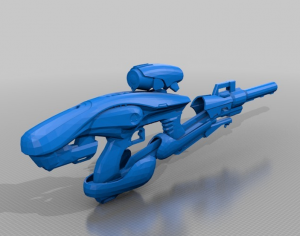
If there’s a fan of the popular Bungie video game Destiny in your life, you can access and 3D print a whole cache of weapons from the game — just in time for Valentine’s Day! Brent Peterson, an independent web developer, brings us the beta version of his generator app — allowing players to 3D print weapons or ships from automatic STL files which he’s also made available on Thingiverse.
Peterson’s generator creates STL files from Bungie’s own official app and website’s source geometry that players use to create characters. Destiny gamers can now 3D print their favorite game weapons, thanks to Peterson’s latest contribution.
Brazilian Students 3D Print Rockets in School’s SpaceCup Competition
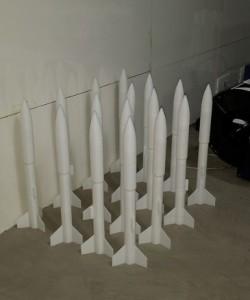 From guns to rockets. This week’s 3D printing news reported that a group of engineering students in the computer engineering and information systems programs at Brazil’s FIAP school competed in SpaceCup — a 3D design and printing rocket launching competition.
From guns to rockets. This week’s 3D printing news reported that a group of engineering students in the computer engineering and information systems programs at Brazil’s FIAP school competed in SpaceCup — a 3D design and printing rocket launching competition.
70 rockets were all 100% 3D printed in ABS plastic using an UP 2 Plus FDM desktop 3D printer. SolidWorks was used to develop the final 3D printed designs and Open Rocket software was used to simulate the designs during the development process. Each rocket had an installed altimeter; one requirement for engineering students was to collect flight data using develop data acquisition software. For information systems students, they had to reach the highest altitude and get closest to a target when landing the rocket.
Each rocket was 3D printed in about one hour and thirty minutes using an average of 37 grams of ABS plastic. Printer layers were set at .3mm in order to speed printing up. All 70 unique rocket designs were printed in 10 days, and once the shells were printed they were outfitted with Brazilian company Bandeirantes’ class C rocket engines with solid propellants to ensure flight.
3D Printed San Francisco Data Artfully Conveys Public Information
Closer to the ground is another newsworthy 3D printed project, this one featuring San Francisco city data. As San Franciso undergoes a sea change due to shifting social demographics from its booming tech industry, and the accompanying gentrification, ‘gkapriel’ posted a project combining information on San Francisco social demographics and 3D printing on Instructables. Infographics condense data into visual displays and have been a very useful tool for scientists, policy makers, activists, and artists who seek to communicate demographic information in new ways.
industry, and the accompanying gentrification, ‘gkapriel’ posted a project combining information on San Francisco social demographics and 3D printing on Instructables. Infographics condense data into visual displays and have been a very useful tool for scientists, policy makers, activists, and artists who seek to communicate demographic information in new ways.
Using publicly accessible data, gkapriel individually mapped nine different social factors that were then 3D printed and unified in one artistic piece. These factors include residential density, no fault evictions/Google bus stops, ambient noise levels, percentage race white, pedestrian victims, bicycle routes and paths, percentage of homeowners, driving distance to hospitals, and median income level. A rapidly changing San Francisco is captured in a way that begs the viewer to see growing eviction rates, income disparities, automobile accidents, and noise levels in a different way.
After organizing data available from the DataSF website, gkapriel then used ArcMap and ArcScene to visualize this data with topical maps. Next, GIS data from 2-dimensional maps were imported into Rhino using the Grasshopper plug-in; 3D models were created from the resulting imported data. Finally, Autodesk’s Meshmixer was used to make 3D printable files, and the final outcome was 3D printed using an Objet Connex 500 resin printer using TangoBlackPlus and Vero White. The results were framed and can now be taken in as a new example of topographical data and 3D printing artwork.
Successful LaserCUSING Method for Dental Industry
Moving from more artistic adaptations of 3D printing to technical news, a new process for 3D printing dental implants and dentures — LaserCUSING or metal laser melting technology — is gaining momentum in the international dental industry, since it has proven successful as an efficient and affordable process. This process is rather simple. It uses 3D CAD data gathered via a 3D scan, modeled, or both to 3D print layers with a laser that melts materials together. Once the product is done being printed, it is finished with aluminum oxide so that the surface is smooth and it is ready for shipping. The LaserCUSING method provides many benefits to the dental industry, including: front-end affordability, ability to work with multiple materials, ability to produce many dentures in one job with one building board, a higher overall production speed, reduction of staffing numbers, reduction of power consumption, and ability to reuse material and eliminate waste. In fact, it has been estimated to cut overall costs for the production of routine implant procedures by 50%. It appears that the metal laser melting method is the wave of the future for dentistry, providing another example of 3D printing’s ability to speed production time and cut costs.
Kickstarter Campaign Launched for EinScan-S Desktop 3D Scanner
Lasers may be working well for the dental industry, but they appear to be old news as white light technology develops as a new scanning technique. A Kickstarter campaign has been launched for an affordable 3D scanner (for 3D printing as well as 3D design) that is 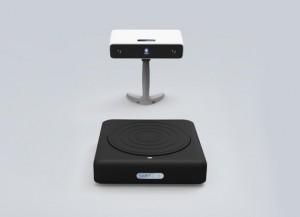 based not on laser technology, but on white light technology instead. The EinScan-S Desktop Scanner, which was introduced at CES earlier this month, is Chinese 3D printer and scanner manufacturer SHINING 3D’s product. The new product promises to bring high quality and affordable 3D scanning to hobbyists and small businesses, and their Kickstarter campaign seeks to raise $50,000. If you pledge $799 you can receive a scanner that will be shipped as early as July 2015 if all goes well.
based not on laser technology, but on white light technology instead. The EinScan-S Desktop Scanner, which was introduced at CES earlier this month, is Chinese 3D printer and scanner manufacturer SHINING 3D’s product. The new product promises to bring high quality and affordable 3D scanning to hobbyists and small businesses, and their Kickstarter campaign seeks to raise $50,000. If you pledge $799 you can receive a scanner that will be shipped as early as July 2015 if all goes well.
Using “structure light phase shifting technology” instead of lasers, white light technology projects a narrow band of light onto an object. This illuminating light is used by a camera to reference the object’s surface shape and specific geometric make-up. The sanning can be sped up by using multiple projections at one time, as well.
The machine has an automatic scan and free scan mode. The automatic mode is the simplest because you place your object on the machine’s rotating surface, and the machine scans the object in 3 minutes down to a 0.1 mm accuracy. The free scan mode is better used on larger objects (up to 700 x 700 x 700 mm), with the machine rotating the scanner on a tripod around the object. You can read more about the machine’s specifications here.
Desktop 3D Printing Advances a Closed-Loop Solution
While some are excited about an affordable desktop 3D scanner, others are still working on some of the old desktop printing problems with exciting new results. Miguel Sánchez‘s quest to develop a closed-loop s ystem (that provides feedback to the printer about a printing job) for printing architecture using a DC motor with an encoder seems to be a step in the right direction for addressing printing problems. Sánchez explains the idea on his blog and even shows video results of his experimentation with improving overall printing jobs by replacing printer stepper motors with one that has an encoder “that will allow the accurate position control that offer the steppers, the machines could be made more reliable and, perhaps, cheaper.” Sánchez still acknowledges that stepper motors offer a “simplicity and elegance” that is difficult to replace, but he’s trying his hardest to do so, as the need for a closed-loop system for desktop printing looms as a major possibility.
ystem (that provides feedback to the printer about a printing job) for printing architecture using a DC motor with an encoder seems to be a step in the right direction for addressing printing problems. Sánchez explains the idea on his blog and even shows video results of his experimentation with improving overall printing jobs by replacing printer stepper motors with one that has an encoder “that will allow the accurate position control that offer the steppers, the machines could be made more reliable and, perhaps, cheaper.” Sánchez still acknowledges that stepper motors offer a “simplicity and elegance” that is difficult to replace, but he’s trying his hardest to do so, as the need for a closed-loop system for desktop printing looms as a major possibility.
German 3D Printing Company SLM Solutions Reports Growth and a New VP
While scanning and desktop printing improvements make this week’s news, larger 3D printing companies report improved sales markets, resulting in financial growth and company expansion. Germany-based SLM Solutions is a leader in the manufacturing of metal 3D printing systems, and it reports 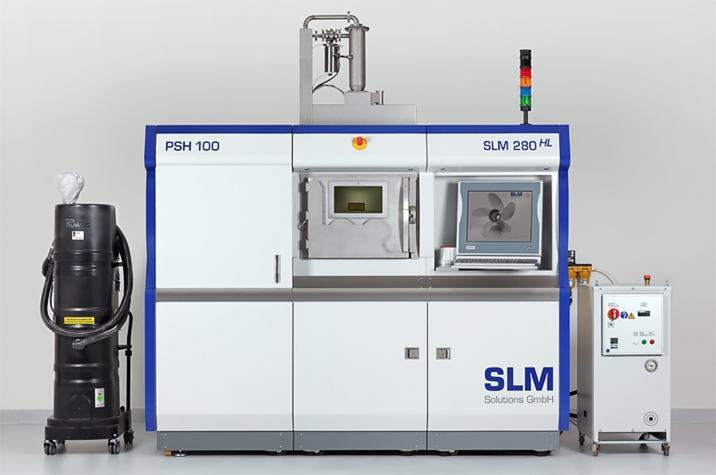 financial growth and has expanded its reach into North America by appointing a new Executive Vice President — Mark Hoefing. This announcement accompanies news that the company has seen 138% growth since 2013. One of it machines, the SLM 500HL, costs around half a million dollars, and in 2014 the company received 62 orders for this machine — up from 26 orders in 2013. The company reports that many of the orders for the machines came in at November’s trade fair, EuroMold, and there’s a growing demand for all of its machines.
financial growth and has expanded its reach into North America by appointing a new Executive Vice President — Mark Hoefing. This announcement accompanies news that the company has seen 138% growth since 2013. One of it machines, the SLM 500HL, costs around half a million dollars, and in 2014 the company received 62 orders for this machine — up from 26 orders in 2013. The company reports that many of the orders for the machines came in at November’s trade fair, EuroMold, and there’s a growing demand for all of its machines.
SLM Solutions’ CEO, Dr. Markus Rechlin, states that “The amplified presence in North America anticipates an increasing demand for fast, flexible and cost efficient systems that are built for metal part and prototype production.” So, it looks like we’ll be seeing more of SLM Solutions as it spreads its North American branches and increases metal printing options at the same time.
From creative Valentine’s Day gift ideas, to technological innovations and experimentation, to reported market growth and expansion — that’s this week’s 3D printing news stories we didn’t have time to cover. Let us know what you thought about these stories in the ‘Stories We Missed’ forum thread on 3DPB.com.
Subscribe to Our Email Newsletter
Stay up-to-date on all the latest news from the 3D printing industry and receive information and offers from third party vendors.
You May Also Like
IperionX Inks 10-Year Deal with Wisconsin Manufacturer for 80 Metric Tons of Titanium Per Year
IperionX, the Charlotte-based supplier of sustainable titanium powders used for additive manufacturing (AM) and metal injection molding (MIM), has signed a ten-year deal with United Stars, a group of industrial...
Gastronology Launches Industrial Production of 3D Printed Food for Dysphagia Patients
Food 3D printing has, in many ways, been an additive manufacturing (AM) segment looking for the right business case. While some applications are beautiful and others may or may not...
Lockheed Martin Leads $3M Investment in Q5D’s Electronics 3D Printing System
Q5D, an original equipment manufacturer (OEM) of robotic arm, hybrid additive manufacturing (AM) systems used for wire harness production, has closed a $3 million investment round. The investment arm of...
3D Printing News Briefs, April 6, 2024: Depowdering, Cybertruck Door Handles, & More
In today’s 3D Printing News Briefs, ioTech’s digital manufacturing CLAD technology is opening up opportunities for microelectronics and additive manufacturing. Hexagon and Raytheon Technologies commercially released the Simufact Additive Process...


